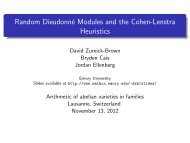alternative lecture notes - Rational points and algebraic cycles
alternative lecture notes - Rational points and algebraic cycles
alternative lecture notes - Rational points and algebraic cycles
You also want an ePaper? Increase the reach of your titles
YUMPU automatically turns print PDFs into web optimized ePapers that Google loves.
A relative functor F : (D, W 1 ) → (C, W 2 ) is a functor D → C such that F (W 1 ) ⊆<br />
W 2 . Denote by RelCat the category of relative categories. There is a forgetful functor<br />
F : RelCat → Cat (forget W ). There is also a functor U : Cat → RelCat sending C to<br />
(C, Iso(C)). The functor U has a left adjoint Ho: RelCat → Cat:<br />
Hom RelCat ((C, W ), U(D)) = Hom Cat (Ho(C), D)<br />
(Here Ho(C) means Ho(C, W ).) Another notation: C[W −1 ] = Ho(C), because it is the<br />
universal category in which the morphisms of W become isomorphisms.<br />
We get equivalences of categories Ho(Set ∆op ) ↔ Ho(Top), but something is lost: these<br />
categories do not have limits <strong>and</strong> colimits. Also, passing to the homotopy category forgets<br />
too much: the morphisms in this category are just π 0 (Map(X, Y )), but we may be interested<br />
in π 1 (Map(X, Y )), etc.<br />
Let TopCat be the category of categories whose Hom sets are topological spaces <strong>and</strong> such<br />
that composition is continuous.<br />
Dwyer–Kan localization of a relative category (also called hammock localization): We define<br />
L H : RelCat → TopCat, sending C to a category L H C with the same objects <strong>and</strong> whose<br />
morphisms between a, b ∈ C are a simplicial set Map L H<br />
C<br />
(a, b). Take the set of zigzags<br />
a ← c 1 → c 2 ← · · · c n → b<br />
where all the left arrows are in W up to equivalence, where equivalence includes<br />
• reversing isomorphisms (replacing an isomorphism by its inverse in the other direction)<br />
• replacing pairs of consecutive maps by their composition (<strong>and</strong> vice versa)<br />
• adding or removing identity morphisms<br />
An edge is an equivalence class of diagrams<br />
<br />
a<br />
<br />
<br />
<br />
c 0<br />
W<br />
c 1<br />
W<br />
· · · c n <br />
<br />
W b<br />
c ′ 0 c ′ 1<br />
· · · c ′ n<br />
<br />
in which the directions of the arrows in the top row are arbitrary but match the directions<br />
in the bottom row. A 2-simplex is an equivalence class of diagrams obtained by “composing”<br />
two edges (to form a wider hammock), <strong>and</strong> so on.<br />
We have π 0 (L H C ) ≃ Ho(C). (Here π 0(L H C ) is the category with the same objects, but in<br />
which each Hom space has been replaced by its set of connected components.)<br />
The space Map L H<br />
C<br />
(a, b) is called the derived mapping space. There is a map of sets<br />
Hom C (a, b) → π 0 (Map L H<br />
C<br />
(a, b)).<br />
Definition 7.2 (Quillen 1969). A model category is (C, W, FIB, COF) where<br />
(1) C is a complete co-complete category,<br />
(2) W , FIB, COF are subcategories with the same objects as C <strong>and</strong> containing the<br />
subcategory of isomorphisms<br />
(3) W satisfies the 2-out-of-3 property<br />
15



